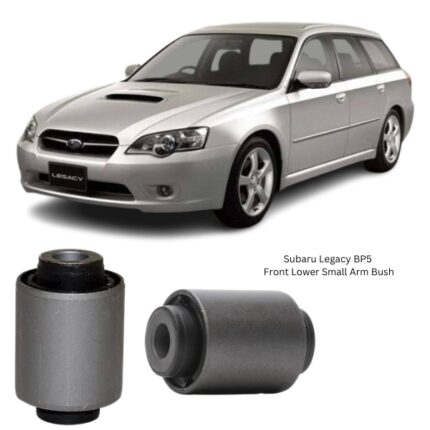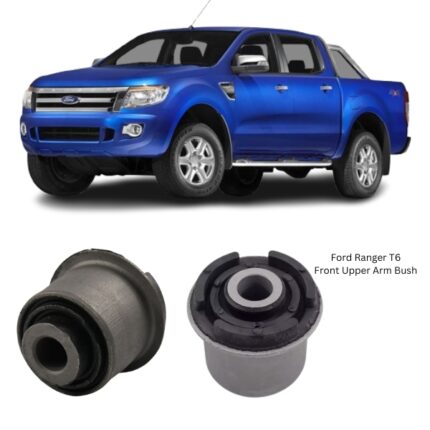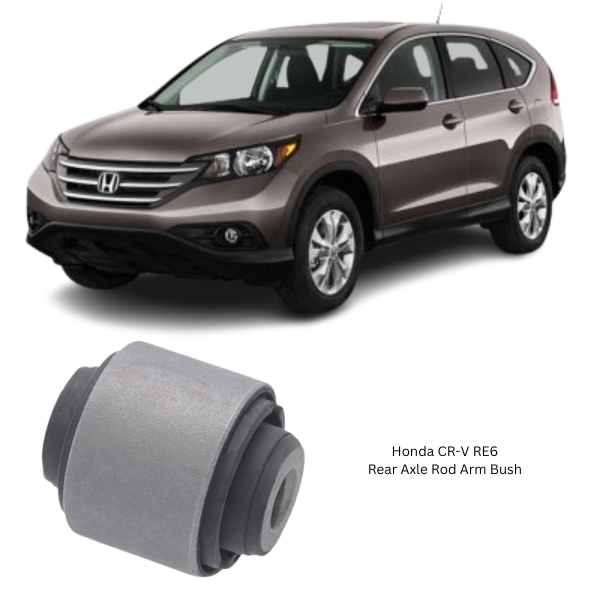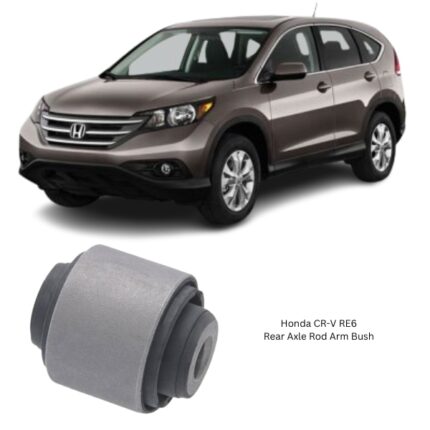Get Honda CR-V RE6 Rear Axle Rod Arm Bush 52364-SJF-004 in Kenya
The Rear Axle Rod Arm Bush is a crucial component within a vehicle’s rear suspension system. Though it may appear small, it plays a pivotal role in supporting the rear axle’s alignment, absorbing vibration, managing road forces, and ensuring smooth articulation of the suspension arms.
This bushing connects the rear axle rod arm—a structural component that links the axle to the vehicle chassis—to the frame or subframe. Its design allows limited movement of the axle in response to road inputs while maintaining alignment, reducing noise, and controlling suspension motion.
Failure or wear in this bushing can lead to reduced vehicle stability, abnormal noise, compromised ride quality, and accelerated wear of related components. As such, the Rear Axle Rod Arm Bush is vital for safe and efficient vehicle operation, especially under dynamic driving conditions or when carrying loads.
Function and Purpose
The Rear Axle Rod Arm Bush acts as a flexible joint between the rear axle rod arm and the chassis or suspension link mounts. It allows the axle arm to pivot or flex slightly during movement, without transmitting harsh forces to the vehicle body. This flexibility is crucial for maintaining a balance between ride comfort and structural integrity.
Primary Functions:
-
Shock Absorption
It cushions the impact of road irregularities, reducing shocks and vibrations that would otherwise be transmitted to the cabin. -
Control of Axle Movement
Limits unwanted motion of the rear axle, especially during acceleration, braking, or cornering. -
Suspension Articulation Support
Allows the rod arm to pivot while holding the axle in proper alignment relative to the vehicle body. -
Noise and Harshness Isolation
Prevents metal-to-metal contact within suspension links, reducing rattling, clunks, and road noise. -
Load Management
Distributes vertical and horizontal forces between the rear axle and the chassis, enhancing ride stability.
By isolating and managing dynamic loads, this bushing contributes to both ride comfort and long-term structural durability.
Construction and Design
The Rear Axle Rod Arm Bush is engineered to withstand frequent flexing, high loads, and varying environmental conditions. It is constructed from materials that balance elasticity with structural rigidity.
Common Design Features:
-
Outer Shell
Typically made from steel or aluminum, this cylindrical sleeve fits into the rear rod arm or mounting bracket and houses the elastomeric core. -
Elastomeric Core (Rubber or Polyurethane)
The core is made of durable rubber or synthetic polymer. It flexes under pressure, absorbs motion, and returns to shape repeatedly. -
Inner Sleeve
A smaller metal insert runs through the center. The suspension bolt passes through this sleeve, anchoring the bushing to the frame or suspension link. -
Bonded Assembly
The elastomer is chemically or mechanically bonded to both the inner and outer sleeves, ensuring no separation under stress. -
Directional Voids (Optional)
Some bushings feature voids or grooves molded into the rubber to manage stiffness in specific directions, optimizing ride quality and durability.
Materials:
-
Natural Rubber offers excellent vibration isolation and comfort.
-
Polyurethane (PU) provides increased performance, reduced deflection, and longer service life in high-load applications.
The design ensures that the bush retains strength while flexing predictably under varying suspension loads.
Performance Characteristics
A properly functioning Rear Axle Rod Arm Bush offers the following advantages:
-
Load Handling
Supports both static loads (vehicle weight) and dynamic forces from acceleration, deceleration, and cornering. -
Fatigue Resistance
Handles thousands of suspension cycles without tearing, cracking, or detachment. -
Environmental Resilience
Withstands exposure to water, salt, oil, heat, and dust without degradation. -
Noise, Vibration, and Harshness (NVH) Control
Reduces NVH transmission into the cabin, maintaining a smooth, quiet ride. -
Directional Stiffness
Engineered to flex in one plane while resisting side-to-side or twisting forces that could compromise alignment.
In harsh driving conditions—such as off-roading, heavy towing, or rough terrain—the bushing’s performance becomes even more critical.
Symptoms of Worn or Damaged Rear Axle Rod Arm Bushes
Over time, bushings deteriorate due to mechanical stress, temperature fluctuations, and exposure to contaminants. A worn rear axle rod arm bush can significantly affect suspension function.
Common Signs of Failure:
-
Clunking or Knocking Noises
Especially when accelerating, decelerating, or going over bumps—caused by increased play in the rod arm joint. -
Rear-End Instability
Loose or vague handling at the rear of the vehicle during turns or braking, often described as a “floating” sensation. -
Increased Vibration
More road feel or vibration felt in the seat or chassis when driving on rough surfaces. -
Uneven or Premature Tire Wear
Misalignment from a loose axle rod arm can alter the suspension geometry and lead to irregular tire wear. -
Visual Wear
Cracked, dry-rotted, or torn rubber on inspection, or visible separation between the rubber and its metal sleeves.
Neglecting these symptoms can lead to further suspension damage and unsafe handling characteristics.
Installation Guidelines
Replacing a Rear Axle Rod Arm Bush typically involves detaching the rod arm from its mounting point, removing the old bush, and pressing in a new one. The procedure may vary depending on the vehicle’s suspension design.
General Installation Steps:
-
Secure the Vehicle
Lift the rear of the vehicle using a jack and secure it with jack stands. -
Remove Rear Wheel and Rod Arm (if required)
Unbolt the rod arm from the chassis or axle. Some applications may allow in-situ bushing replacement; others require arm removal. -
Extract Old Bush
Use a hydraulic press or appropriate tool to press out the worn bush. -
Install New Bush
Press the new bushing into place, taking care to align it correctly within the rod arm housing. -
Reassemble and Torque
Refit the rod arm, tighten all bolts to specified torque values, and ensure proper orientation. -
Test and Inspect
Perform a short road test and visual inspection to confirm installation and suspension function. -
Wheel Alignment (if needed)
If the suspension geometry was disturbed, an alignment may be necessary to restore correct tracking.
Maintenance and Inspection
Although the Rear Axle Rod Arm Bush does not require regular maintenance or lubrication, it should be visually inspected during:
-
Routine suspension or brake service
-
Rear shock or spring replacement
-
After off-road driving or harsh weather exposure
-
During tire rotation or alignment services
Preventive inspection and timely replacement help maintain suspension integrity and prevent costly damage.
Benefits of Timely Replacement
-
Enhanced Ride Comfort
Eliminates unwanted vibrations and harshness from entering the cabin. -
Stable Rear-End Handling
Ensures consistent axle movement, keeping the vehicle stable during turns and sudden maneuvers. -
Improved Safety
Restores proper axle alignment, crucial for braking and directional control. -
Even Tire Wear
Preserves correct suspension angles, protecting tires from premature wear. -
Extended Component Life
Reduces wear and stress on rod arms, axle brackets, and mounting hardware.
Follow us on Facebook for more parts.





Reviews
Clear filtersThere are no reviews yet.